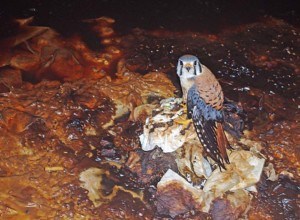 [/media-credit]
[/media-credit]
By D.C. Ruhlen. Sept. 6, 2016. Youth Submission. Are you eating a meal? Maybe you should read this later. Oh good, you’re still here. This is an essay about a man-made disaster involving vault toilets, porta-potties (snicker), and birds. Many porta-potties have a fume pipe, to keep the smell to a minimum. Unfortunately, curious birds attempting to find a nesting or roosting space accidentally fall in and get covered in poo. That’s where the Poo-Poo Project comes in.
The project aim is to prevent wildlife from becoming entraped in vent pipes found in vault toilets throughout the United States. It is a project of the Teton Raptor Center, a non-profit organization dedicated to helping raptors.
People can check the fume pipes though several methods (the method I am most familiar with involves a telescoping pole and a mirror). If the pipe is open, they can cover the top with a metal grate, so that no more birds will fall in. This is a disgusting job, but it has to be done to ensure no more potty-accidents.
Each year thousands of cavity-nesters and animals die in vent pipes, chimneys, or other open pipes. The poo-poo project has saved many a bird’s life, and is very helpful to the environment. The birds that have been saved include: Boreal Owls, Northern Saw-whet Owls, Northern Pygmy Owls, Burrowing Owls, Long-eared Owls, Gila Woodpeckers, American Kestrels and Northern Flickers. We have many of these species in the Columbia Gorge.
Cathy Flick, a former U. S. Forest Service biologist, who was with me when my family and I were checking the pipes, said she had found trapped or dead animals in open pipes in the Gorge: Vaux’s Swifts, bats, alligator lizards, and other small creatures.
The Poo-Poo Project website says that bodies of 200 dead birds were discovered in a single irrigation pipe in California. In Nevada, open pipes are used as mining claim stakes and in one survey of 854 pipes, 879 dead birds, 113 dead reptiles, and 20 small mammals were found.
Video of the author checking vault toilets in the Gorge
My Experience
My personal experience with the Poo-Poo Project was two to three hours of checking some vault toilet fumes pipes in the Columbia Gorge to see if the openings were covered. To do so, we took a telescoping pole and attached a broken-off motorcycle mirror with rubber bands.
When I was the carrier, I would make the pole longer and hold it over the fumes pipe so we could see inside. The only times I was nervous was when we were close to a power line and when a bald face hornet started getting agitated at the mirror.
Even though this sounds like a bad job, it really isn’t. That still doesn’t mean I jumped at the idea in the first place. Helping out with the Poo-Poo Project also really makes you connected with nature. It also will change how you look at a porta-potty for the rest of your life!
What You Can Do
First of all, the most important thing you can do is participate yourself! For example, porta-potties are not the only problem try also looking at your house or farm to see if it has any small smooth tubes (chimneys, irrigation pipes) that birds can enter and get trapped in.
Also, try being directly involved! This can include: doing what I did, covering a potty with a grate; or you could sponsor a grate, get a group together for this project, or consult local wildlife agencies and porta-potty services and let them know you are concerned.
I listed all the vault toilets I checked on my trip in July 2016 below. Some of our local agencies managing vault toilets are ‘poo-poo’ partners and I listed below the Oregon and Washington partners. Last year, the Teton Raptor Center sold to partners and individuals about 5,000 poo-poo grates; in 2016 it is already close to 7,000. This project is a great way to lessen our impact on wildlife.
Recorded Potties (our data, July 2016)
#1 Coyote Wall parking lot vault toilet
Manager: Columbia Gorge Scenic Area recently joined as a poo-poo partner in July of this year and purchased screens to cover their vault toilet vents
Results: not screened, no top hat
The Columbia Gorge Scenic Area
#2 Rowland Lake toilet
Manager: Washington department of fish and wildlife
Results: has grate on top with holes too small for birds to fit it and no fume pipe (good)
#3 Balfour Klickitat vault toilet
Manager: Columbia Gorge Scenic Area
Results: no screen, no top hat
#4 Lyle, Washington trailhead – Klickitat trail toilet
Manager: Columbia Gorge Scenic Area
Results: too high to safely check with pole.
#5 Lyle, Washington, 3rd and Klickitat Streets – port a potty
Manager: Bishop Sanitation.
Results: no grate, no top hat. Pipe is pretty small, but birds like Vaux’s Swift that roost in the adjacent building’s chimney or bats can enter and because of the smooth surface (unlike the inside of the brick chimney), they cannot get back out
#6 Chamberlain rest area toilet
Manager: Washington Department of Transportation
Results: the pipe is bent closed, preventing animals from coming in (good)
Poo-Poo Partners in Oregon and Washington:
Oregon
BLM Burns District Office
BLM Klamath Falls Resource Area
BLM Lakeview District Office
USACE John Day Dam, Portland District
USFS Columbia River Gorge National Scenic Area
USFS Deschutes National Forest (East Cascade Audubon Society)
USFS Deschutes National Forest, Bend Fort Rock Ranger District
USFS Fremont-Winema National Forest, Lakeview Ranger District
USFS Malheur National Forest, Prairie City Ranger District
USFS Rogue River-Siskiyou National Forest, Gold Ranger District
Washington
BLM Spokane District Office
USFS Colville National Forest, Sullivan Lake Ranger District
USFS Colville National Forest, Newport Ranger District
USFS MT. Baker- Snoqualmie National Forest, Mt. Baker Ranger District






I wanted to let you know that your blog and note kicked off quite a discussion here, re: how we can take part, specifications for new facilities as old ones go offline, etc. We wanted to thank you, and we are glad that you found our local vault toilets to be good. So far I have not been able to confirm that is the case throughout the state on WDFW lands, and I am not sure we can do that in any reasonably short period of time given how far and wide our operations are distributed in the state, but people here are enthused about your work and we think you are on the right track.
Thank you for your service to wildlife and people. We admire people who do the tough jobs, and you are doing that.
Thanks again DC,
Jason Wettstein
Public Affairs and Community Relations
Washington Department of Fish and Wildlife
Thank you so much Mr. Wettstein. DC really appreciated your comment. At 12 years old, having people like you take his work to heart and really consider it and make policy changes will be something he will take with him into the future. It is motivating him to take action for what he believes in and he is already thinking of future project ideas to write about.
We have also heard from the Columbia River Gorge National Scenic Area that they have received 16 screens and are starting to install them. The Teton Raptor Center just announced that The Dalles Dam just became the 205th Poo-Poo Partner. Progress is being made in the Gorge to prevent these tragedies. Thank you.
DC…..Your article gave light to a problem that I wasn’t even aware of. But now I will always wonder about pipes, especially in outhouses. You did very good research to back up your thoughts and your writing is very good and indicates that you are a person who cares about nature.
Hope you keep involved in finding solutions to difficult problems like “poo poo” pipes.